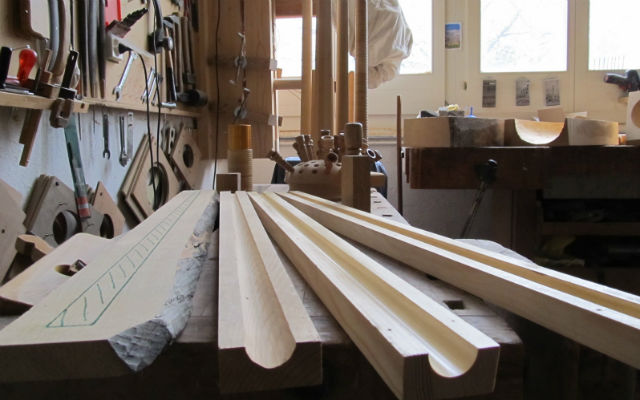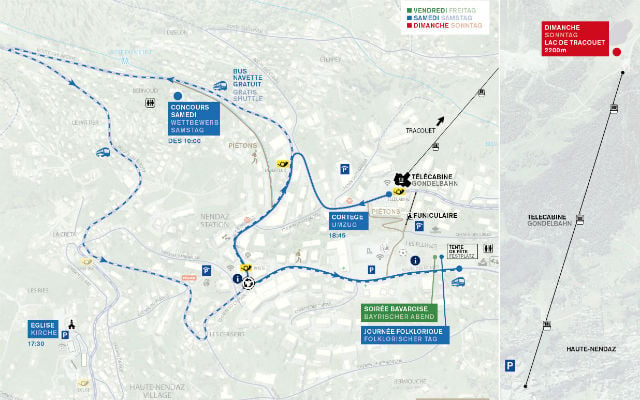The ancient 'megaphone' of the Alps returns for its annual Swiss gala

With the Valais Alphorn Festival set to bring together 12,000 enthusiasts of the 'Swiss didgeridoo' from today until Sunday we take a closer look at the roots of the instrument and the people keeping the tradition alive.
Its deep, echoing call has reverberated throughout the peaks of the Alps for centuries. A sort of ancient megaphone – or community radio – the alphorn, at over three metres long, is far more than simply a large instrument.
"The alphorn served to announce news from one valley to another. It was used to warn of the arrival of an enemy, a fire or the occurrence of natural damage," Sonia Délèze, head of communications for the Valais Alphorn Festival – the 17th edition of which kicks off today in Nendaz, in the canton of Valais – told The Local.
"Each 'type of news' corresponded to a particular sound. The Alpine horn was also used to call back herds at the end of the day," added Délèze.
Like a sort of community radio, the alphorn can echo throughout a whole valley – its powerful sound can travel up to 10 kilometres from source.
This year, 180 alphorn players are set to compete in the festival, known officially as the Valais Drink Pure Festival, in several categories. More than 75 per cent are Swiss, but French, German – and even a Japanese – musician will make their way to the Alps to show off their lip vibration skills.
The festival hosts competitions, as well as Swiss wrestling bouts, an artisan and gastronomy fair, and a plethora of other ancient customs embedded deep in the roof of Europe.
The master cratfsmen
The alphorn is made of spruce wood, often from trees centuries-old, found deep in the woods of the Jura Mountains in western Switzerland.
"It takes two weeks to make one," François Morisod, one of the country's main producers of the instrument, told The Local. "We go to the forests of the Jura to source the wood, which is sometimes over 200 years old," added the master horn maker.

Alphorn maker François Morisod at his workshop in Lavey. Photo: François Morisod.
The resonance wood – the same kind used to make violins and guitars – is taken to a sawmill and then dried, before being carefully crafted at Morisod's workshop in Lavey, a small village near Sion in western Switzerland. Once the wood is dry, Morisod selects, hollows and carves the best bits to produce the right tonality.
Once the instrument is ready, Morisod, who is also a sculptor and painter, adds the finishing touches.
"I paint the alphorns with motifs from the Alps. Floral patterns, edelweiss, the mountains and hunting symbols are some of the most popular," says Morisod.
Morisod makes about 20 alphorns per year and each instrument costs approximately 3,500 Swiss francs (€3500) to purchase. His buyers are mainly Swiss, but on average each year three or four off his production line are sold to clients from afar as Japan, China and the USA.

François Morisod's studio in Levay, near the home of the festival, in the French-speaking canton of Valais. Photo: François Morisod.
Last year, approximately 12,000 people visited the Valais Drink Pure Festival, with a similar number of enthusiasts expected this year. On the final day, Sunday, 30 per cent of attendants are foreign visitors, mainly from France, Belgium, Germany, and the Netherlands, the festival's Délèze told The Local.
The alphorn is a distinctly Swiss horn, but variants or even ancestors of the instrument can be seen from Australia to Latin America, and even across Europe.
The alphorn has played a pivotal role in Swiss history, just like the kora in West Africa, the didgeridoo in Australia or the mbira in Zimbabwe.
"In 1661, a travelling herdsman from Eggiwil was prosecuted for causing a night-time disturbance by playing the alpine horn. In Entlebuch in 1653, its calls signalled the rallying of the peasant revolt. In the 17th century, travelling alphorn players would busk for their food in towns," notes Morisod's website.
Writers and artists, from the Hungarian painter Jozsef Molnar to French philosopher Jean-Jacques Rousseau, were enchanted by its sound and mystique. Rousseau, author of philosophy text 'The Social Contract', noted that one alphorn tune was "so cherished amongst the Swiss that playing it amongst their troops was prohibited under sentence of death, because it caused he who heard it to break down in tears, to desert, or to die."
Despite such historical appreciation, "it almost fell into oblivion 30 years ago," Morisod told The Local. "But it has come back strongly," he added.
One reason is the exposure provided by the Valais Drink Pure Festival, founded in 2002. Each year, dozens of musicians compete in the competition's five categories: solo, group, champions (those who have already competed in previous editions), 'masters' (any participant who graded above a certain level of points in past editions) and the youth section. The winner in each category receives 750 Swiss francs (€645).
The champion player
Participants are judged according to several criteria. These include sound quality, precision breathing technique, mobility, intonation, as well as rhythm and articulation, according to the festival's competition rules.
Myriam Petit, a French musician from Annecy in France, won the 2017 solo competition, although she never expected to become an Alpine champion. "In 2004, the director of the orchestra I was in said I am putting together an alphorn band and I think you should try out," Petit told The Local. "It kind of worked out," says the modest musician, who has won the Valais Alphorn Festival solo competition three times.

Myriam Petit, winner of the 2017 solo competition, holds her trophy. Photo: Myriam Petit/Les Sonneurs de Savoye.
Petit, who also used to play the hunting horn, the cavalry trumpet and several other wind instruments, is part of Les Sonneurs de Savoye troupe, based in France. She estimates that there are 300 to 400 alphorn players living in French mountain provinces like Alsace near the Swiss and German alpine borders.
Petit says she gave up playing all other instruments when she discovered her love for the alphorn, known as 'cor des Alpes' in French.
"The satisfaction when you play it well is unparallelled," she told The Local, adding that the secret – given that the instrument has no valves – lies purely in lip vibration. "The line between good and bad is very thin and when it's bad, it's unforgivable. I've been through all the fazes," says the alphorn master.
The festival
The Valais Drink Festival programme starts Friday July 20th and runs until Sunday July22nd. There is a free shuttle bus to move around the festival's activities, the highlight of which is the grand final on Sunday at 14:30. Entry for most events is free, although the grand final charges visitors 16 Swiss Francs (€13) to attend.
Getting there and away: Visitors can take a train to Sion from Geneva (just under two hours) or Lausanne (one hour), and then reach the events through the picturesque ski lifts.

READ MORE: What you need to know about Switzerland’s Unspunnen, the world's largest traditional festival
Comments
See Also
Its deep, echoing call has reverberated throughout the peaks of the Alps for centuries. A sort of ancient megaphone – or community radio – the alphorn, at over three metres long, is far more than simply a large instrument.
"The alphorn served to announce news from one valley to another. It was used to warn of the arrival of an enemy, a fire or the occurrence of natural damage," Sonia Délèze, head of communications for the Valais Alphorn Festival – the 17th edition of which kicks off today in Nendaz, in the canton of Valais – told The Local.
"Each 'type of news' corresponded to a particular sound. The Alpine horn was also used to call back herds at the end of the day," added Délèze.
Like a sort of community radio, the alphorn can echo throughout a whole valley – its powerful sound can travel up to 10 kilometres from source.
This year, 180 alphorn players are set to compete in the festival, known officially as the Valais Drink Pure Festival, in several categories. More than 75 per cent are Swiss, but French, German – and even a Japanese – musician will make their way to the Alps to show off their lip vibration skills.
The festival hosts competitions, as well as Swiss wrestling bouts, an artisan and gastronomy fair, and a plethora of other ancient customs embedded deep in the roof of Europe.
The master cratfsmen
The alphorn is made of spruce wood, often from trees centuries-old, found deep in the woods of the Jura Mountains in western Switzerland.
"It takes two weeks to make one," François Morisod, one of the country's main producers of the instrument, told The Local. "We go to the forests of the Jura to source the wood, which is sometimes over 200 years old," added the master horn maker.

Alphorn maker François Morisod at his workshop in Lavey. Photo: François Morisod.
The resonance wood – the same kind used to make violins and guitars – is taken to a sawmill and then dried, before being carefully crafted at Morisod's workshop in Lavey, a small village near Sion in western Switzerland. Once the wood is dry, Morisod selects, hollows and carves the best bits to produce the right tonality.
Once the instrument is ready, Morisod, who is also a sculptor and painter, adds the finishing touches.
"I paint the alphorns with motifs from the Alps. Floral patterns, edelweiss, the mountains and hunting symbols are some of the most popular," says Morisod.
Morisod makes about 20 alphorns per year and each instrument costs approximately 3,500 Swiss francs (€3500) to purchase. His buyers are mainly Swiss, but on average each year three or four off his production line are sold to clients from afar as Japan, China and the USA.

François Morisod's studio in Levay, near the home of the festival, in the French-speaking canton of Valais. Photo: François Morisod.
Last year, approximately 12,000 people visited the Valais Drink Pure Festival, with a similar number of enthusiasts expected this year. On the final day, Sunday, 30 per cent of attendants are foreign visitors, mainly from France, Belgium, Germany, and the Netherlands, the festival's Délèze told The Local.
The alphorn is a distinctly Swiss horn, but variants or even ancestors of the instrument can be seen from Australia to Latin America, and even across Europe.
The alphorn has played a pivotal role in Swiss history, just like the kora in West Africa, the didgeridoo in Australia or the mbira in Zimbabwe.
"In 1661, a travelling herdsman from Eggiwil was prosecuted for causing a night-time disturbance by playing the alpine horn. In Entlebuch in 1653, its calls signalled the rallying of the peasant revolt. In the 17th century, travelling alphorn players would busk for their food in towns," notes Morisod's website.
Writers and artists, from the Hungarian painter Jozsef Molnar to French philosopher Jean-Jacques Rousseau, were enchanted by its sound and mystique. Rousseau, author of philosophy text 'The Social Contract', noted that one alphorn tune was "so cherished amongst the Swiss that playing it amongst their troops was prohibited under sentence of death, because it caused he who heard it to break down in tears, to desert, or to die."
Despite such historical appreciation, "it almost fell into oblivion 30 years ago," Morisod told The Local. "But it has come back strongly," he added.
One reason is the exposure provided by the Valais Drink Pure Festival, founded in 2002. Each year, dozens of musicians compete in the competition's five categories: solo, group, champions (those who have already competed in previous editions), 'masters' (any participant who graded above a certain level of points in past editions) and the youth section. The winner in each category receives 750 Swiss francs (€645).
The champion player
Participants are judged according to several criteria. These include sound quality, precision breathing technique, mobility, intonation, as well as rhythm and articulation, according to the festival's competition rules.
Myriam Petit, a French musician from Annecy in France, won the 2017 solo competition, although she never expected to become an Alpine champion. "In 2004, the director of the orchestra I was in said I am putting together an alphorn band and I think you should try out," Petit told The Local. "It kind of worked out," says the modest musician, who has won the Valais Alphorn Festival solo competition three times.

Myriam Petit, winner of the 2017 solo competition, holds her trophy. Photo: Myriam Petit/Les Sonneurs de Savoye.
Petit, who also used to play the hunting horn, the cavalry trumpet and several other wind instruments, is part of Les Sonneurs de Savoye troupe, based in France. She estimates that there are 300 to 400 alphorn players living in French mountain provinces like Alsace near the Swiss and German alpine borders.
Petit says she gave up playing all other instruments when she discovered her love for the alphorn, known as 'cor des Alpes' in French.
"The satisfaction when you play it well is unparallelled," she told The Local, adding that the secret – given that the instrument has no valves – lies purely in lip vibration. "The line between good and bad is very thin and when it's bad, it's unforgivable. I've been through all the fazes," says the alphorn master.
The festival
The Valais Drink Festival programme starts Friday July 20th and runs until Sunday July22nd. There is a free shuttle bus to move around the festival's activities, the highlight of which is the grand final on Sunday at 14:30. Entry for most events is free, although the grand final charges visitors 16 Swiss Francs (€13) to attend.
Getting there and away: Visitors can take a train to Sion from Geneva (just under two hours) or Lausanne (one hour), and then reach the events through the picturesque ski lifts.

READ MORE: What you need to know about Switzerland’s Unspunnen, the world's largest traditional festival
Join the conversation in our comments section below. Share your own views and experience and if you have a question or suggestion for our journalists then email us at [email protected].
Please keep comments civil, constructive and on topic – and make sure to read our terms of use before getting involved.
Please log in here to leave a comment.